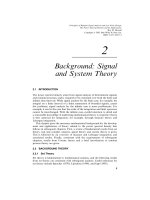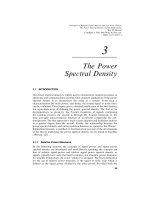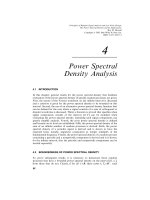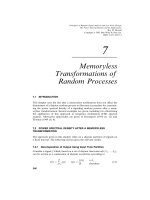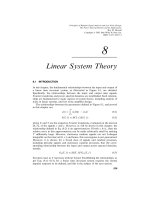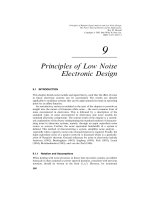Tài liệu Nguyên tắc phân tích tín hiệu ngẫu nhiên và thiết kế tiếng ồn thấp P5 doc
Bạn đang xem bản rút gọn của tài liệu. Xem và tải ngay bản đầy đủ của tài liệu tại đây (494.57 KB, 41 trang )
5
Power Spectral Density
of Standard Random
Processes — Part 1
5.1 INTRODUCTION
In Chapters 5 and 6 the power spectral density of commonly encountered
random processes are given in detail. Specifically, the power spectral density of
random processes associated with signaling, quantization, jitter, and shot noise
are discussed in this chapter, while the power spectral density associated with
sampling, quadrature amplitude modulation, random walks, and 1/ f noise, are
discussed in Chapter 6.
In this chapter, the random processes discussed have a general form that is
associated with signaling, and the terminology of a signaling random process
is introduced. The results associated with signaling random processes are used
in Chapter 7, to detail an approach for determining the power spectral density
of a random process after a nonlinear memoryless transformation.
5.2 SIGNALING RANDOM PROCESSES
As defined below, the signal form associated with signaling is such that
signaling random processes are found in models for a diverse range of physical
processes. For example, signaling random processes include baseband and
certain bandpass communication processes. The signal form of interest is that
of an information signal.
D:I S An information signal is one generated by
a sum of signals from a ‘‘signaling set,’’ where one signal is associated with each
138
Principles of Random Signal Analysis and Low Noise Design:
The Power Spectral Density and Its Applications.
Roy M. Howard
Copyright
¶
2002 John Wiley & Sons, Inc.
ISBN: 0-471-22617-3
signaling interval of D sec. With a signaling set E
, an information signal has
the form
G
(
G
, t 9 (i 9 1)D) (5.1)
where + E
and
G
is an index variable which defines the signal from E
that
is associated with the ith signaling interval [(i 9 1)D, iD].
D:S R P A signaling random process X,is
one whose ensemble consists of information signals. The ensemble E
6
charac-
terizing such a random process for the interval [0, ND]is
E
6
:
x(
, ...,
,
, t) :
,
G
(
G
, t 9 (i 9 1)D),
G
+ S
, + E
(5.2)
where
G
+ S
and the vector (
,...,
,
) is an element of S
6
: S
;%;S
,
which is an index set to distinguish between waveforms in the ensemble.
S
3 Z> for the countable case and S
3 R for the uncountable case. Equiv-
alently,
,...,
,
are the respective outcomes of N identically distributed
random variables
,...,
,
, and is used to denote any one of these. The
sample space associated with is S
.
Associated with each element of the set S
, or equivalently with each
outcome of the random variable , is a signal, and this association defines the
set or ensemble of signaling waveforms, E
:
E
: +(, t): + S
, (5.3)
The probability of any given signal from the signaling set is given by the
probability of the associated outcome from , that is,
P[(, t)] : P[] : p
A
P[(, t)"
AZA
M
A
M
>BA
] : P[+ [
M
,
M
; d]] : f
(
M
) d
countable case
uncountable case
(5.4)
where f
is the probability density function of the random variable for the
uncountable case. The probability associated with waveforms in E
6
are
P[x(
, ...,
,
, t)] : P[
, ...,
,
] : p
A
A
,
countable case
P[x(
, ...,
,
, t)"
A
G
Z'
G
]:
'
%
'
,
f
,
(
, ...,
,
) d
...d
,
uncountable case
(5.5)
SIGNALING RANDOM PROCESSES
139
where p
A
A
,
and f
,
, respectively, are the joint probability of
,...,
,
for the countable case and the joint probability density function of
...
,
for
the uncountable case. For the independent case
p
A
A
,
: p
A
...p
A
,
f
,
(
, ...,
,
) : f
(
) ... f
,
(
,
)(5.6)
Finally, the Fourier transform of a signaling waveform + E
, evaluated
over the interval (9-, -),is
(, f ) :
\
(, t)e\HLDR dt + S
(5.7)
5.2.0.1 Example — Standard Communication Signals Each outcome
of a signaling random process X is an individual signal, and with an
appropriate signaling set, is suitable for use in a communication system. For
the case of signaling at a constant rate r : 1/D, there are two standard
information signals defined on the interval [0, ND] according to
y(
, ...,
,
, t) :
,
G
A
A
G
(t 9 (i 9 1)D)
G
+ S
: +1, ..., M,
A
A
G
+ +A
, ..., A
+
,
P[A
G
] : P[
G
] : p
A
G
(5.8)
x(
, ...,
,
, t) :
,
G
(
G
, t 9 (i 9 1)D)
G
+ S
: +1, ..., M,
+ E
P[(
G
, t)] : P[
G
] : p
A
G
(5.9)
where E
: +(
G
, t):
G
+ S
,. The signaling waveforms are of a pulse form for
baseband communication and A
, ..., A
+
are signaling amplitudes.
The first signal defined above is one where a constant pulse shape is used,
and the information is encoded through use of different amplitudes. The second
is where different signaling waveforms are used to convey information. Clearly,
the second form is more general and includes the first as a subcase. An example
of the second signaling form is shown in Figure 5.1, where E
:+(1, t), (2, t),,
and
(1, t) :
A cos(2f
A
t) sin(t/D)
0
t+ [0, D]
elsewhere
(5.10)
(2, t) :
A sin(2f
A
t) sin(t/D)
0
t+ [0, D]
elsewhere
(5.11)
The plotted signal is x(1, 2, 2, 1, 1, t), for the case where A : 1, D : 1, and
f
A
: 4 Hz.
140
POWER SPECTRAL DENSITY OF STANDARD RANDOM PROCESSES — PART 1
1 2 3 4 5
−0.75
−0.5
−0.25
0
0.25
0.5
0.75
1
Time (Sec)
x(1, 2, 2, 1, 1, t)
Figure 5.1 Baseband signaling waveform, A : 1, D : 1, and f
c
: 4.
Note, if the duration of all signaling waveforms in the signaling set is kD
sec, then at any time t after the first k transient signaling intervals, there are
potentially k nonzero waveforms comprising the signal x.
5.2.0.2 Generality of Information Signal Form A broad class of signals
can be written in an information signal form. To illustrate this, consider first,
the fact that any bandlimited signal x can be written, on the interval (9-, -),
in the information signal form (Gabel, 1987),
x(t) :
G\
x(iD) sinc
t 9 iD
D
(5.12)
Second, consider that any signal x with bounded variation can be written,
on an interval [0, ND], in the information signal form according to
x(
, ...,
,
, t) :
,
A
A
G
(t 9 (i 9 1)D)
A
G
+ S
,
G
+ R (5.13)
where S
is the set of signals with bounded variation on the interval [0, D] and
which are zero outside this interval.
5.2.1 Power Spectral Density of a Signaling Random Process
The following theorem details the power spectral density of a signaling random
process.
SIGNALING RANDOM PROCESSES
141
T 5.1. P S D S R P
Assuming the effect of including components of the signaling waveform outside of
the interval [0, ND] is negligible, the dependency between signaling waveforms
depends on the difference between the location of the signaling intervals and not
on their absolute location, and the ith signaling waveform is independent of the
jth signaling waveform for "i 9 j"9m, then the power spectral density of the
random process X, defined by the ensemble as per Eq. (5.2), is
G
6
(ND, f ) : r"( f )" 9 r"
( f )";r"
( f )"
1
N
sin(Nf /r)
sin(f/r)
; 2r
K
G
1 9
i
N
Re[eHLG"D(R
>G
( f ) 9 "
( f )")]
(5.14)
G
6
( f ) : r"( f )" 9 r"
( f )";r"
( f )"
L\
( f 9 nr)
; 2r
K
G
Re[eHLG"D(R
>G
( f ) 9 "
( f )")]
(5.15)
where r : 1/D and
( f ) :
A
p
A
(, f ) countable case
\
(, f ) f
() d uncountable case
(5.16)
"( f )" :
A
p
A
"(, f )" countable case
\
"(, f )" f
() dy uncountable case
(5.17)
R
>G
( f )
:
A
A
>G
p
A
A
>G
(
, f )*(
>G
, f ) countable case
\
\
(
, f )*(
>G
, f ) f
>G
(
,
>G
) d
d
>G
uncountable case
(5.18)
142
POWER SPECTRAL DENSITY OF STANDARD RANDOM PROCESSES — PART 1
For the independent case R
G
>G
( f ) : "
( f )" and
G
6
(ND, f ) : r"( f )" 9 r"
( f )";r"
( f )"
1
N
sin(Nf /r)
sin(f/r)
(5.19)
G
6
( f ) : r"( f )" 9 r"
( f )";r"
( f )"
L\
( f 9 nr) (5.20)
Proof. The proof is given in Appendix 1.
5.2.1.1 Notes The results stated in the above theorem for the independent,
countable, and infinite interval case are consistent with those of van den Elzen
(1970).
The given expressions for G
6
(ND, f ) and G
6
( f ) can be written in a simpler
form with the variance definition
( f ) : "( f )" 9 "
( f )" (5.21)
however, the given forms best facilitate evaluation of the power spectral
density.
As the discrete and independent case, where there are M possible signaling
waveforms, commonly occurs the following explicit expressions are useful:
G
6
(ND, f ) : r
+
A
p
A
"(, f )";r
+
A
p
A
(, f )
1
N
sin(Nf /r)
sin(f/r)
9 1
(5.22)
G
6
( f ) : r
+
A
p
A
"(, f )"9r
+
A
p
A
(, f )
(5.23)
; r
+
A
p
A
(, f )
L\
( f 9 nr)
The equations specified in Theorem 5.1 can be considerably simplified if the
mean of the Fourier transform of the signaling waveforms
, is zero. A
sufficient condition for this is for the mean of the signaling waveforms to be
zero, that is,
(t) : 0 for t + (9-, -), where
is defined, respectively, for the
countable and uncountable cases according to
(t) :
A
p
A
(, t)
(t) :
\
(, t) f
() d (5.24)
When
(t) : 0 for t + (9-, -), it follows for the countable case that
( f ) :
A
p
A
(, f ) :
A
p
A
\
(, t)e\HLDR dt
(5.25)
:
\
A
p
A
(, t)
e\HLDR dt : 0
SIGNALING RANDOM PROCESSES
143
The interchange of summation and integration in this equation is valid,
according to the dominated convergence theorem, when there exists a function
g+ L , such that
+
A
p
A
(, t) : g(t) for all values of M + Z>. A typical case is
where sup+"(, t)": + Z>, is bounded and integrable on the infinite interval,
and for this case the interchange is valid. A similar argument can be used for
the uncountable case.
5.2.1.2 Case 1: Mean of Signaling Waveforms is Zero For the case
where the mean of the signaling waveforms is such that
( f ) : 0 for f + R,
the results given in Theorem 5.1, for the power spectral density of a signaling
random process, simplify to
G
6
(ND, f ) : r"( f )" ; 2r
K
G
1 9
i
N
Re[eHLG"DR
>G
( f )]
(5.26)
G
6
( f ) : r"( f )" ; 2r
K
G
Re[eHLG"DR
>G
( f )]
When
: 0 and the signaling waveforms in different signaling intervals are
independent, the simple result
G
6
(ND, f ) : G
6
( f ) : r"( f )" : G
(D, f ) (5.27)
holds, where G
is the power spectral density of the random process defined
by the ensemble E
, as per Eq. (5.3), that is,
G
(D, f ) :
1
D
A
p
A
"(, f )" countable case
1
D
\
"(, f )"f
() d uncountable case
(5.28)
Consistent with Eq. (5.7), the contribution of the signaling waveform compo-
nents outside of the interval [0, D] are included in this power spectral density
definition.
5.2.1.3 Case 2: Information Encoded in Pulse Amplitudes Consider
the case where information is encoded in the pulse amplitudes, such that
(, t) :A()(t), and
E
:
A()(t): A() :
A
A
A()
+ Z>
+ R
countable case
uncountable case
(5.29)
where
P[A
A
] : P[] : p
A
P[A()"
AZA
M
A
M
>BA
] : f
(
M
) d (5.30)
144
POWER SPECTRAL DENSITY OF STANDARD RANDOM PROCESSES — PART 1
It then follows that
( f ) :
( f )
A
p
A
A
A
:
( f ) countable case
( f )
\
A() f
() d :
( f ) uncountable case
(5.31)
"( f )" :
"( f )"
A
p
A
"A
A
":"( f )""A" countable case
"( f )"
\
"A()"f
() d : "( f )""A" uncountable case
(5.32)
where,
and "A", respectively, are the mean and mean square value of the
signaling amplitudes. Further,
R
>G
( f ) :
"( f )"
A
A
>G
p
A
A
>G
A
A
A
*
A
>G
countable case
"( f )"
\
\
A(
)A*(
>G
) f
>G
(
,
>G
) d
d
>G
uncountable case
: "( f )"R
>G
(5.33)
where, p
A
A
>G
is the joint probability of
in the first signaling interval and
>G
in the 1 ; ith signaling interval, or equivalently, the joint probability of the
amplitude A
A
in the first signaling interval, and the amplitude A
A
>G
in the
1 ; ith signaling interval. Similarly, f
>G
is the joint probability density
function for amplitudes in the first and 1 ; ith signaling intervals. The
definition for R
>G
is obvious from this equation. With these definitions, it
follows that
G
6
(ND, f ) : r"( f )"
"A" 9 "
";"
"
1
N
sin(Nf /r)
sin(f/r)
; 2
K
G
1 9
i
N
Re[eHLG"D(R
>G
9 "
")]
(5.34)
G
6
( f ) : r"( f )"
"A" 9 "
";r"
"
L\
( f 9 nr)
; 2
K
G
Re[eHLG"D(R
>G
9 "
")]
(5.35)
SIGNALING RANDOM PROCESSES
145
The variance definition
: "A" 9 "
" (5.36)
can simplify the form of these equations. Carlson (1986 pp. 388—389) gives
equivalent results.
For the independent case, where R
>G
: "
", it follows that
G
6
(ND, f ) : r"( f )"
"A" 9 "
";"
"
1
N
sin(Nf /r)
sin(f/r)
(5.37)
G
6
( f ) : r"( f )"
"A" 9 "
";r"
"
L\
( f 9 nr)
(5.38)
For the independent case, where the mean amplitude
is zero, the simpler
result follows:
G
6
(ND, f ) : G
6
( f ) : r"A" "( f )":r
"( f )" (5.39)
5.2.2 Examples and Spectral Issues for Communication Systems
The above theory has direct application to communication of information via
signaling waveforms, as the power spectral density contains the following
information. First, whether there are signal components in the transmitted
signal which do not convey information. Such components are periodic, show
up as impulses in the power spectral density, and indicate inefficient signaling.
Second, how spectrally efficient the signaling scheme is in terms of the level of
information transmitted in the frequency band containing the majority of
signal energy. The usual measure here is the number of bits of information per
Hz of bandwidth. A greater degree of spectral efficiency allows a greater
number of signal or information channels in a specified frequency band. Third,
the degree of spectral rolloff associated with the residual signal energy outside
of the band used to measure spectral efficiency. The degree of spectral rolloff is
a measure of the spectral spread and such spread impairs the ability of a
receiver associated with an adjacent signal channel to recover a signal in that
adjacent channel.
The following examples give some insight into these issues, although they
primarily illustrate the evaluation of the power spectral density of a signaling
random process.
5.2.2.1 Example: Power Spectral Density of a Return to Zero Signal
Consider the case of a signaling random process, defined for the interval
146
POWER SPECTRAL DENSITY OF STANDARD RANDOM PROCESSES — PART 1
D
t
1
D ⁄ 2
φ(t)
Figure 5.2 Pulse waveform.
[0, ND] by the ensemble
E
7
:
y(
, ...,
,
, t) :
,
G
A
A
G
(t9(i91)D),
G
+ +1, 2,, A
: 0, A
: A
(5.40)
and the pulse waveform has the form shown in Figure 5.2. Signaling with
such a waveform is called ‘‘return to zero’’ (RZ) signaling. The Fourier
transform of is
( f ) :
1
2r
sinc
f
2r
e\HLDP r : 1/D (5.41)
Assuming independent and equally probable amplitudes, such that
:
A/2, A : A/2,
: A/4, and R
>G
: "
" for i . 1, it then follows from
Eqs. (5.37) and (5.38), that the power spectral density is given by
G
7
(ND, f ) :
A
16r
sinc
f
2r
1 ;
1
N
sin(Nf /r)
sin(f/r)
(5.42)
G
7
( f ) :
A
16r
sinc
f
2r
;
A
16
sinc
f
2r
L\
( f 9 nr) (5.43)
The power spectral density is plotted in Figure 5.3 for the case of N : 256,
D : 1, r : 1, and A : 1. Clearly evident in this figure is the continuous sinc
squared form and the discrete ‘‘impulsive’’ components. For the case where
A : 1, the power in the impulsive components at frequencies 0, r,2r,3r, ...is
1/16, 0, 1/4, 0, 1/36, . . . . In Figure 5.4, the power spectral density for the
infinite interval is plotted using logarithmic scaling.
The following can be inferred from these power spectral density graphs.
First, the impulses in the spectrum are wasted power as far as communication
of information is concerned, and thus, RZ signaling is inefficient signaling. The
impulsive components, however, may facilitate synchronization and data
recovery at the receiver. Second, the signaling pulse is relatively narrow, which
SIGNALING RANDOM PROCESSES
147
0.5 1 1.5 2 2.5 3 3.5 4
0.02
0.04
0.06
0.08
0.1
Frequency (Hz)
G
Y
(256D, f)
Figure 5.3 Power spectral density of a RZ signal when D : 1, r : 1, A : 1, and N : 256.
implies a relatively broad spectrum, which, in turn, implies relatively poor
spectral efficiency. The main lobe of the power spectral density is from 92r to
2r Hz, that is, a bandwidth of 2r Hz. This implies a spectral efficiency of 0.5
bit/Hz, which is low when compared with, for example, signaling with raised
cosine pulses as shown in the next example. Third, the envelope of the power
spectral density rolls off at a 1/ f rate which is generally inadequate for most
communication systems.
5.2.2.2 Example: Power Spectral Density of a Bipolar Signal Consider
the case of a signaling random process, characterized on the interval [0, ND]
by the ensemble
E
6
:
x(
, ...,
,
, t) :
,
G
(
G
, t9(i91)D), + E
,
G
+ +91, 0, 1,
(5.44)
where
E
: +(
G
, t): (
G
, t) :
G
p(, t 9 D/2),
G
+ +91, 0, 1,, (5.45)
p(, t) : A sinc
t
D
cos(t/D)
1 9 (2t/D)
(5.46)
Here, p(, t) is the inverse Fourier transform of a raised cosine spectrum, which
148
POWER SPECTRAL DENSITY OF STANDARD RANDOM PROCESSES — PART 1
0.05
0.1
0.5
1
5
10
0.0001
0.0005
0.001
0.005
0.01
0.05
0.1
G
Y
∞
( f )
Frequency (Hz)
Figure 5.4 Power spectral density of a RZ signal evaluated on the infinite interval when D : 1,
r : 1, and A : 1. The dots represent the power in impulsive components. The power in the
impulse at 0 Hz is 0.0625.
is defined according to (Carlson, 1986 p. 406; Proakis, 1995 p. 546)
P(, f ) :
A
r
" f ":
r
2
(1 9 )
A
r
cos
2
" f "9r(19)/2
r
r
2
(19) -"f ":
r
2
(1;)
0 " f ".
r
2
(1 ; )
(5.47)
where r : 1/D. P is shown in Figure 5.5 for the cases of : 0.5 and : 1.0.
The parameter is the rolloff factor and is such that 0 :-1. The graph of
p(, t) is shown in Figure 5.6 for the cases of : 0.5 and : 1.0.
A bipolar signal is generated when binary data is encoded with no waveform
corresponding to a logic 0, and with logic 1 being encoded alternatively with
p and 9p as illustrated in Figure 5.7. This encoding leads to correlation
between adjacent signaling waveforms, but ensures the signaling set has zero
mean for the case of equally probable data.
Consistent with this encoding, it follows from Eq. (5.26) that the power
spectral density of the signaling random process is
G
6
(ND, f ) : r"( f )"
; 2r
1 9
1
N
Re[eHL"DR
( f )] (5.48)
SIGNALING RANDOM PROCESSES
149
0.2 0.4 0.6 0.8 1
0.2
0.4
0.6
0.8
1
β = 0.5
P(β, f )
Frequency (Hz)
β = 1
Figure 5.5 Raised cosine spectrum for the case where r : A : 1.
−2
−1 0 1 2 3
0
0.2
0.4
0.6
0.8
1
Time (Sec)
p(β, t)
β = 1
β = 0.5
Figure 5.6 Inverse Fourier transform of raised cosine spectrum for the case where D : A : 1.
where
"( f )" :
A\
p
A
"(, f )"
(5.49)
R
( f ) :
A
\
A
\
p
A
A
(
, f )*(
, f )
150
POWER SPECTRAL DENSITY OF STANDARD RANDOM PROCESSES — PART 1
2 4 6 8 10
−1
−0.5
0
0.5
1
Time (Sec)
x(1, 0, 1, 1, 1, 1, 0, 0, 1, 0, t)
Figure 5.7 Bipolar signaling waveform where pulses associated with a raised cosine spectrum
have been used. : 1, D : 1, A : 1, and data is
+
1, 0, 1, 1, 1, 1, 0, 0, 1, 0
,
.
TABLE 5.1 Possible Outcomes for Two Consecutive Signaling Intervals
Data Signaling Waveforms Probabilities
00 0, 0 p
00
: 0.25
01 0, (91, t )or0,(1, t) p
0,91
: p
01
: 0.125
10 (91, t ), 0 or (1, t ), 0 p
91,0
: p
10
: 0.125
11 (91, t), (1, t )or(1, t), (91, t ) p
91,1
: p
1,91
: 0.125
In these equations, p
\
: p
: 0.25 and p
: 0.5. By considering possible data
and the corresponding signaling waveforms in two consecutive signaling
intervals, it follows that the probabilities of two consecutive signaling wave-
forms, that is P[(
, t), (
, t)] : p
A
A
, are as tabulated in Table 5.1. Using
the results in this table, it follows that
"( f )" : 0.5"P(, f )" and R
( f ) :90.25"P(, f )"
and hence,
G
6
(ND, f ) : 0.5r"P(, f )"
1 9
1 9
1
N
cos(2f/r)
(5.50)
G
6
( f ) : r sin(f/r)"P(, f )" (5.51)
where the relationship sin(A) : 0.5 9 0.5 cos(2A) has been used. The power
SIGNALING RANDOM PROCESSES
151
0.2 0.4 0.6 0.8 1
0.1
0.2
0.3
0.4
0.5
0.6
β = 1
Frequency (Hz)
G
X
∞
( f )
β = 0.5
Figure 5.8 Power spectral density of a signaling random process using pulses associated with
a raised cosine spectrum, bipolar coding and with D : r : A : 1.
spectral density is plotted in Figure 5.8 for the case of N ; - when : 0.5
and : 1.0.
In comparison with RZ signaling, the following can be noted. First, the
bipolar coding ensures that the signaling random process has a zero mean, and
therefore, there are no impulses and no redundant signal components in the
power spectral density. Second, the signaling is more spectrally efficient. For
example, with : 1, the spectrum is bandlimited to r Hz which implies 1
bit/Hz (twice as efficient as RZ signaling). Third, on the infinite interval with
no truncation of the signaling pulses defined in Eq. (5.46), the spectral rolloff
is infinite (there is no spectral spread). In practice, the signaling pulses are
truncated and this results in spectral spread which can be readily determined.
Finally, the encoding ensures that the power spectral density is zero at zero
frequency, ensuring that a bipolar signal can be passed by a linear system
whose transfer function has zero response at dc.
5.3 DIGITAL TO ANALOGUE CONVERTER QUANTIZATION
Increasingly, information signals are generated via a digital processor that
generates very accurate sample values, and these are put to a M bit digital to
analogue converter (DAC), at a constant rate of r : 1/D samples/sec. To
ascertain the power spectral density of the generated signal, consider a M bit
DAC with 2+ equally spaced levels between and including <A. The difference
between DAC levels is denoted , where : 2A/(2+ 9 1). Associated with the
ith sample value x
G
, is a quantization error
G
, as illustrated in Figure 5.9, such
152
POWER SPECTRAL DENSITY OF STANDARD RANDOM PROCESSES — PART 1
A
−A
∆
y
i
ε
i
x
i
Figure 5.9 Illustration of quantization error with a 2-bit DAC (4 levels).
that in the ith sample interval [(i 9 1)D, iD], the constant level y
G
: x
G
;
G
is
generated. The model is one of an additive error to an ideal signal. In general,
the actual levels in a DAC will vary from device to device because of
manufacturing tolerances and will vary with device age, etc. Accordingly, it is
appropriate to consider an infinite ensemble of DACs, where each is driven by
the same sample values, such that in the i th sample interval
G
is independent
of x
G
when considered across the ensemble. From the nature of quantization, it
follows that
G
takes on values with a uniform distribution, from the interval
[9/2, /2). A further assumption is that the DAC resolution and rate of
signal change are such that the quantization errors from one sample interval
to the next are uncorrelated. With such assumptions, the ensemble of DAC
output signals for the interval [0, ND], which define a random process Y,is
E
7
:
y(
, ...,
,
, t) :
,
G
(x
G
;
G
)(t 9 (i 9 1)D)
: x
1
(t) ;
,
G
G
(t 9 (i 9 1)D)
G
+
9
2
,
2
(5.52)
where is a pulse function defined according to
(t) :
1
0
0 - t : D
elsewhere
"( f )" :
1
r
sinc
f
r
(5.53)
and x
1
(t) is a step approximation to the desired signal x, that is,
x
1
(t) :
,
G
x
G
(t 9 (i 9 1)D) (5.54)
The probabilities associated with the quantization error are such that
P[
G
+ [
M
,
M
;d]] : f
C
(
M
) d
DIGITAL TO ANALOGUE CONVERTER QUANTIZATION
153


